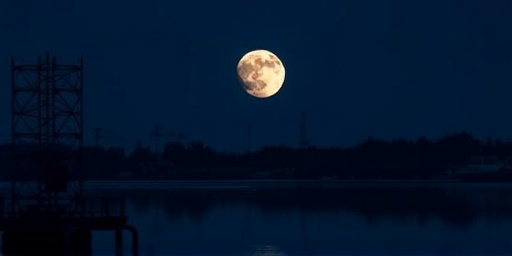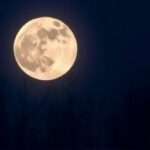Stargazers across the United States are gearing up for a celestial spectacle as the brightest Supermoon of 2025 prepares to dominate the night sky this week. Dubbed the Full Beaver Moon, this event will peak in illumination on November 5 and remain visible through November 6, offering an extraordinary display for astronomy enthusiasts and casual skywatchers alike.
- Why the Full Beaver Moon Stands Out as 2025’s Brightest Supermoon
- Unveiling the Science Behind Supermoon Illumination and Visibility
- Prime Skywatching Locations and Tips for Capturing the November Supermoon
- Broader Impacts: How the Supermoon Influences Tides, Wildlife, and Culture in November 2025
- Looking Ahead: Upcoming Celestial Events Following the 2025 Beaver Moon
According to NASA astronomers, this Supermoon will appear about 14% larger and 30% brighter than a typical full moon, thanks to the moon’s closest approach to Earth during its full phase. The phenomenon, which occurs when a full moon coincides with perigee—the point in the lunar orbit nearest to our planet—promises to be the most luminous of the year. With clear skies forecasted in many regions, millions are expected to witness this rare alignment, marking a highlight in November 2025‘s skywatching calendar.
The excitement is building among the astronomy community, with observatories from coast to coast urging the public to step outside and marvel at the glowing orb. ‘This Supermoon isn’t just a pretty sight; it’s a reminder of the dynamic dance between Earth and the moon,’ said Dr. Elena Vargas, a senior astronomer at the Griffith Observatory in Los Angeles. Her words capture the blend of science and wonder that defines events like this.
Why the Full Beaver Moon Stands Out as 2025’s Brightest Supermoon
The Full Beaver Moon earns its title from Native American and colonial traditions, signaling the time when beavers busily prepare their dams for winter. But beyond folklore, its astronomical credentials make it exceptional. In November 2025, the moon will reach perigee at just 356,460 kilometers from Earth—closer than any other full moon this year. This proximity amplifies its apparent size and brilliance, outshining the other three supermoons anticipated in 2025: those in October, December, and a partial one in September.
Supermoons have fascinated humanity for centuries, with records dating back to ancient civilizations like the Babylonians who tracked lunar cycles meticulously. Modern data from the U.S. Naval Observatory confirms that this event’s peak illumination will hit 99.9% on November 5 at 7:20 PM EST, making it ideal for evening observations. Compared to the average full moon distance of 384,400 kilometers, the difference is stark: the supermoon will reflect sunlight more intensely, casting a silvery glow that could even influence tides more noticeably along coastlines.
Statistics from past supermoons illustrate their impact. The 2016 supermoon trio, for instance, drew over 10 million social media posts worldwide, according to analytics firm Brandwatch. Experts predict similar fervor for November 2025, with apps like SkySafari and Stellarium already seeing spikes in downloads among skywatching hobbyists.
Unveiling the Science Behind Supermoon Illumination and Visibility
Delving deeper into the mechanics, a supermoon occurs roughly every 14 months, but the intensity varies based on the exact perigee timing. For November 2025, the alignment is near-perfect, with the full moon phase syncing within hours of perigee. This results in enhanced tidal forces; ocean tides could rise up to 20% higher than usual, affecting maritime activities from the Gulf of Mexico to the Pacific Northwest.
Astronomy professionals emphasize the role of atmospheric conditions in visibility. Clear, low-humidity nights will allow the moon to shine without distortion, while urban light pollution poses the biggest challenge. A study by the International Dark-Sky Association reveals that 80% of Americans live under light-polluted skies, yet rural areas in states like Montana and Wyoming offer prime viewing spots where the supermoon will appear unhindered.
Quotes from leading experts add depth to the anticipation. ‘The brightness of this supermoon will make it a textbook case for understanding lunar phases and orbital dynamics,’ notes Dr. Raj Patel, director of the Hayden Planetarium at the American Museum of Natural History. He recommends binoculars for spotting subtle details like lunar maria—those dark basaltic plains that give the moon its mottled appearance.
To quantify the event, consider this: the moon‘s angular diameter will measure 34.14 arcminutes, versus the usual 31 arcminutes. This enlargement isn’t just visual; it subtly affects nocturnal wildlife behaviors, with research from the University of Washington indicating increased owl activity and deer movements under brighter full moons.
Prime Skywatching Locations and Tips for Capturing the November Supermoon
For those planning to engage in skywatching, selecting the right location is key. In the U.S., national parks like Yellowstone and the Grand Canyon provide dark-sky sanctuaries, free from city glare. Coastal observers in Florida and California might enjoy the supermoon rising over the ocean, creating a picturesque horizon effect. Urban dwellers aren’t left out—rooftop vantage points in New York City or Chicago can still yield impressive views if pollution is minimal.
Practical tips abound for maximizing the experience. Start by checking local weather apps; the National Weather Service predicts mostly clear conditions across the Midwest and Southeast on November 5-6. Dress warmly, as November nights dip below freezing in northern states. For photography enthusiasts, use a DSLR with a telephoto lens at ISO 100 and shutter speeds around 1/125th second to freeze the moon‘s motion without blur.
- Timing is everything: The best viewing window is from moonrise on November 5 until dawn on November 6, when the moon is highest in the sky around midnight.
- Tools for enhancement: Apps like The Photographer’s Ephemeris can predict the moon‘s path relative to landmarks, aiding composition.
- Safety first: Avoid direct telescope eyepiece use without filters to prevent eye strain from the intensified light.
Community events are ramping up too. The Smithsonian National Air and Space Museum in Washington, D.C., is hosting a free virtual astronomy webinar on November 4, featuring live Q&A with experts. Local astronomy clubs, such as the Astronomical Society of the Pacific, report doubled attendance for their supermoon watch parties.
Historical context enriches the narrative. The last comparably bright supermoon was in 2020, which coincided with a penumbral lunar eclipse, drawing global attention. This year’s event stands alone, allowing undivided focus on the moon‘s grandeur.
Broader Impacts: How the Supermoon Influences Tides, Wildlife, and Culture in November 2025
Beyond aesthetics, the Full Beaver Moon carries tangible effects. Tidal experts from NOAA warn of spring tides peaking 2-3 feet higher than neap tides, potentially leading to minor coastal flooding in vulnerable areas like Louisiana’s bayous. Fishermen and surfers should monitor advisories, as stronger currents could alter routines.
In the realm of wildlife, the enhanced moonlight disrupts natural rhythms. A 2023 study in the Journal of Astronomy and Astrophysics linked supermoons to shifts in bird migration patterns, with species like the snowy owl becoming more active. Ecologists in Alaska anticipate heightened beaver activity—fitting the moon’s namesake—as the brighter nights extend their foraging time.
Culturally, the Full Beaver Moon resonates deeply. Indigenous tribes, including the Algonquin, named it for the industrious rodents fortifying lodges before freeze-up. Colonial Americans adopted the term, embedding it in almanacs like the Old Farmer’s Almanac, which still publishes skywatching guides today. In modern pop culture, supermoons inspire art and media; expect social media trends with #BeaverMoon2025 to surge, potentially amassing billions of views on platforms like Instagram and TikTok.
Quotes from cultural historians provide perspective. ‘This supermoon bridges ancient wisdom and contemporary science, reminding us of our shared sky,’ says Professor Maria Lopez of the University of Arizona’s Indigenous Studies program. Her insight underscores the event’s role in fostering cross-generational connections through astronomy.
Environmental angles also emerge. With climate change altering viewing conditions—such as increased cloud cover from shifting weather patterns—organizations like the Sierra Club are using the supermoon to advocate for dark-sky preservation. Initiatives in states like Arizona aim to expand protected areas, ensuring future generations can enjoy unspoiled skywatching.
Looking Ahead: Upcoming Celestial Events Following the 2025 Beaver Moon
As the glow of the November supermoon fades, astronomy lovers have more to anticipate. December 2025 brings another supermoon, the Cold Moon, slightly less bright but paired with the Geminid meteor shower peaking on December 13-14, promising up to 120 shooting stars per hour. Early 2026 will feature a total lunar eclipse in March, visible across the Americas.
These events highlight a banner year for celestial happenings, encouraging sustained interest in skywatching. Telescopes sales are projected to rise 15% post-supermoon, per industry reports from Celestron. Educational outreach is expanding too, with NASA’s Artemis program tying lunar observations to future moon missions, inspiring the next generation of explorers.
In essence, the Full Beaver Moon serves as a gateway to deeper engagement with the cosmos. Whether through binoculars or the naked eye, this November 2025 event invites everyone to pause and ponder our place in the universe, setting the stage for a year of stellar discoveries.









